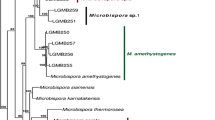Abstract.
The nucleotide sequences of 16S rDNAs (coding for the small subunit ribosomal RNAs) were used to identify Xylella fastidiosa, a nutritionally fastidious plant pathogenic bacterium. The near-complete 16S rDNAs from nine strains of Xyl. fastidiosa, including seven pathotypes and one strain of Xanthomonas campestris pv. campestris, were amplified through PCR with two conserved primers (forward primer 5′-AGA GTT TGA TCC TGG CTC AG-3′ and reverse primer 5′-AAG GAG GTG ATC CAG CC-3′) and sequenced. The 16S sequences were compared with all eukaryote and prokaryote DNA entries in GenBank database. A Xyl. fastidiosa 16S rDNA sequence, M26601, was determined to be the most similar to all the near-complete (1537 bp) and partial 5′ end sequences from Xyl. fastidiosa, but not those from the Xanthomonas strain. A 20-bp oligonucleotide (5′-TTG GTA GTA ATA CCA TGG GT-3′) was found to be highly characteristic of Xyl. fastidiosa. Since the 16S rDNA of Xyl. fastidiosa strains are highly homologous and characteristically different from other bacteria, including the most closely related Xanthomonas, 16S rDNA sequences can be used as signature characters to identify this bacterium.
Similar content being viewed by others
Author information
Authors and Affiliations
Additional information
Received: 22 June 1999 / Accepted: 2 August 1999
Rights and permissions
About this article
Cite this article
Chen, J., Banks, D., Jarret, R. et al. Use of 16S rDNA Sequences as Signature Characters to Identify Xylella fastidiosa . Curr Microbiol 40, 29–33 (2000). https://doi.org/10.1007/s002849910006
Issue Date:
DOI: https://doi.org/10.1007/s002849910006




